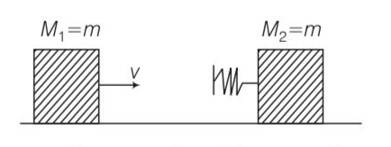A proton is kept at rest. A positively charged particle is released from rest at a distance d in its field. Consider two experiments; one in which the charged particle is also a proton and in another, a positron. In the same time t, the work done on the two moving charged particles is
(a) Same as the same force law is involved in the two experiments.
(b) Less for the case of a positron, as the positron moves away more rapidly and the force on it weakens.
(c) More for the case of a positron, as the positron moves away a larger distance.
(d) Same as the work done by charged particle on the stationary proton.
A proton is kept at rest. A positively charged particle is released from rest at a distance d in its field. Consider two experiments; one in which the charged particle is also a proton and in another, a positron. In the same time t, the work done on the two moving charged particles is
(a) Same as the same force law is involved in the two experiments.
(b) Less for the case of a positron, as the positron moves away more rapidly and the force on it weakens.
(c) More for the case of a positron, as the positron moves away a larger distance.
(d) Same as the work done by charged particle on the stationary proton.
-
1 Answer
-
This is a multiple choice answer as classified in NCERT Exemplar
(c) Force between two protons is same as that of between proton and a positron. As positron is much lighter than proton, it moves away through much larger distance compared to proton.
We know that work done = force (distance). As forces are same in case of proton and positron but distance moved by positron is larger, hence work will be more.
Similar Questions for you
Using Newton’s formula,
This is a multiple choice answer as classified in NCERT Exemplar

This is a multiple choice answer as classified in NCERT Exemplar
(b) conserving energy between “O” ans ”A”

Ui + Ki = Uf + Kf
0+1/2mv2= mgh + 1/2mv’
(v’)2=v2-2gh = v’= ……….1
Let speed after emerging be v1 then
=1/2mv12=1/2[1/2mv’2]
1/2m(v1)2=1/4m(v’)2=1/4m[v2-2gh]
V1= ………….2
From eqn 1 and 2
So v1 = v’/ =v2(v’/2)
v1>v’/2
hence after emerging from the target velocity of the bullet is more than half of its earlier velocity v’
(d) as the velocity of the bullet changes to v’ which is less than v’ hence , path
This is a multiple choice answer as classified in NCERT Exemplar
(b, d) When a man of mass m climbs up the staircases of height L, work done by the gravitational force on the man is mgl work done by internal muscular forces will be mgL as the change in kinetic is almost zero.
Hence total work done =-mgL + mgL=0
As the point of application of the contact forces does not move hence work done by reaction forces will be zero.
This is a multiple choice answer as classified in NCERT Exemplar
(c) m =150g =3/20kg
Time of contact =0.001s
U=126km/h=
V= -35m/s
Change in momentum of the ball = m (v-u)=
=21/2
F= dp/dt=- = - 1.05
Here – negative sign indicates that force will be opposite to the direction of movement of the ball before hitting.
Taking an Exam? Selecting a College?
Get authentic answers from experts, students and alumni that you won't find anywhere else
Sign Up on ShikshaOn Shiksha, get access to
- 65k Colleges
- 1.2k Exams
- 679k Reviews
- 1800k Answers

